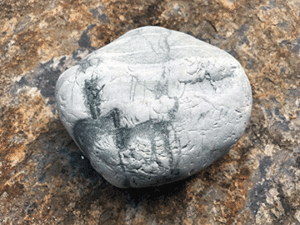By Mary Reddy
Rock Talk
By Mary Redy
During my apprenticeship to a shaman, I learned how to journey into the non-ordinary reality of the lower, middle, and upper worlds where I met with power animals, nature spirits, deities, and all manner of beings for which I had no name. My first attempts were tentative yet soon enough I was surprised by some very real alternate realities. When going to the upper world for the first time, I expected to see ethereal castles and cloud cities. I thought I’d meet austerely other-worldly teachers. Instead, I wandered as though in a fog and began to worry that I would fail to see anything. Suddenly, I found myself in the presence of an old crone of a woman with wild hair and wilder eyes. I appeared to have startled her. She turned from something she was working on, took one look at me, and yelled in consternation “Go talk to rocks!” Her hoarse voice and peremptory command shocked me back home. Journey ended. Message received.
I followed her advice. In the beginning, I would touch into a rock and get a clear sense of its intelligent but foreign-to-me nature. Eventually, my rock communions expanded to include something like rock emotion. For example, I once leaned into the cliff cradling the Baptism River as it rushed down a gorge into Lake Superior. The Rock Being I connected with exuded a rocky delight that I cared to visit and proceeded to convey wordlessly how much it enjoyed shedding its minerals into the river, tinging it a copper. Part of its earthly mission was to hold the swift-flowing water on its course to the deep lake. I still believe it had much more to “tell” me if I’d had the patience of a rock to listen for hours.
Another time, touching an old standing stone in Ireland that was carved with tree runes, I heard a delighted voice that said “Ah, you’re back!” Then I felt as though I was atop the rock and we were flying through the night skies. I can’t explain what that was about, but it moved me to happy tears.
Here on Whidbey Island, I go for walks in a Buddhist nature reserve known as the Earth Sanctuary where they have created a standing-stone circle using slabs of Columbia Gorge basalt. I walk the circle, greeting each stone. Every time I perform this ritual, I am struck by a peculiar sensation when touching the stone slabs. I feel the exact opposite of grounded and immobile stability. I feel a watery current, a rushing and waving motion moving through dark space. Some of the standing stones convey this energetic feeling more strongly than others; with one, the sensation is quite strong ( the 11th in the circle proceeding clockwise). It reminds me of the flying sensation I experienced with the stone in Ireland. I can journey to stones at a distance, but the physical touching of stone is precious to me.
We humans have interacted with stones for eons, performing ceremonies in standing stone circles, carving runes on stones and painting wild animals on cave walls, using hot stones for physical healing or crystal stones for concentration of light and intention. Someone told me once that stones hold memories. Our histories and the history of the planet may be stored in stone. I wonder if it’s possible for humans to co-author stories with stones? Is that what happened with the ancient standing stones? Was the meaning embedded in sacred stones through human beings collaborating with stones, angels, or Sidhe? Or were the messages generated by other beings to communicate with us? Whether collaboration took place in the past, perhaps it’s time to experiment with it now.
It’s been years since I learned shamanic practices. Later, discovering incarnation spirituality, I realized a key difference between the two approaches to journeying or attunement. In shamanic journeying, I learned to leave the body behind. My consciousness departs the surrounding environment to enter a full-on trance state. Incarnational spirituality, with its joyous acknowledgement of embodiment, encourages me to involve my whole self. I retain awareness of my body and invite my environment to accompany me in fellowship. Thus, the touching of stones physically carries a powerful charge for me, as it works on a Gaian wavelength.
I'd love to hear from you about your experiences with stones. And if this is new to you, I invite you to “Go talk to rocks!” (and bring your body along with you!)
On September 28, join Lorian teacher Susan Sherman for a free webinar on Energy Tending. In this one hour interactive webinar on Zoom, you will learn a simple and effective practice that can shift your inner landscape towards a more welcoming, loving and connected way of meeting the world in your daily life. For more information and to register, click here.



 A sense of urgency always overtakes me when I get to an airport, even when I am in plenty of time. It’s the overall vibe, I suppose, of a seeming non-place—everyone there is rushing off to somewhere else or working to get people from here to there. The muffled, sub-sonic vibration of jets overhead and the smell of diesel that permeates everything adds to the unsettled feeling.
A sense of urgency always overtakes me when I get to an airport, even when I am in plenty of time. It’s the overall vibe, I suppose, of a seeming non-place—everyone there is rushing off to somewhere else or working to get people from here to there. The muffled, sub-sonic vibration of jets overhead and the smell of diesel that permeates everything adds to the unsettled feeling. As I looked around me at the mass of people being processed by armed, uniformed officials, my mood shifted into something darker and more troubling. Suddenly, we were not air passengers having our bags checked for bombs and knives, we were refugees being herded into camps, prisoners in a gulag, illegal aliens captured for incarceration and deportation. The scene around me was superimposed in my mind with images of Jews being unloaded from cattle cars and sorted on train platforms, of women in headscarves being harassed by military troops. On top of anger, I was flooded with grief about the cruelty humanity visits upon itself. Clearly these weren’t all my own thoughts and feelings, but why was I picking up on them so strongly?
As I looked around me at the mass of people being processed by armed, uniformed officials, my mood shifted into something darker and more troubling. Suddenly, we were not air passengers having our bags checked for bombs and knives, we were refugees being herded into camps, prisoners in a gulag, illegal aliens captured for incarceration and deportation. The scene around me was superimposed in my mind with images of Jews being unloaded from cattle cars and sorted on train platforms, of women in headscarves being harassed by military troops. On top of anger, I was flooded with grief about the cruelty humanity visits upon itself. Clearly these weren’t all my own thoughts and feelings, but why was I picking up on them so strongly? I reviewed the morning’s events from a clairvoyant perspective. I saw the emotional residue of thousands of people’s irritation, fear and frustration accumulating in the check point area, like an ecosystem overburdened with toxic runoff. There were vague shapes moving among the heavy residues, perhaps a combination of projections and thought-forms left behind by travelers, and more autonomous beings who find nourishment in such an environment, like rats in a garbage-strewn lot.
I reviewed the morning’s events from a clairvoyant perspective. I saw the emotional residue of thousands of people’s irritation, fear and frustration accumulating in the check point area, like an ecosystem overburdened with toxic runoff. There were vague shapes moving among the heavy residues, perhaps a combination of projections and thought-forms left behind by travelers, and more autonomous beings who find nourishment in such an environment, like rats in a garbage-strewn lot.  On September 28, join Lorian teacher Susan Sherman for a free webinar on
On September 28, join Lorian teacher Susan Sherman for a free webinar on  I spent a day in the northern section of Yellowstone National Park this past summer. It was a brief visit, but nonetheless powerful in connecting me with the formative forces building our world. There were geysers spewing out hot bubbling minerals not safe to be touched by human hands, powerful rivers cutting channels in the landscape and various microbial life-forms wearing down rock. My day’s experience was an amazing window into the forces that tirelessly move, meet and mold a world.
I spent a day in the northern section of Yellowstone National Park this past summer. It was a brief visit, but nonetheless powerful in connecting me with the formative forces building our world. There were geysers spewing out hot bubbling minerals not safe to be touched by human hands, powerful rivers cutting channels in the landscape and various microbial life-forms wearing down rock. My day’s experience was an amazing window into the forces that tirelessly move, meet and mold a world. On the way home to Michigan, I found myself considering my own relationship to formative forces, not looking to those powers of nature outside myself but to those powers available within my human stream of action. Standing, Partnering, and Generativity – these are not geologic forces but human-centered formative forces that I can direct— each elemental and powerful in their way. They work with elements of creation different from the geologic forces, but they are no less potent to the life of Gaia.
On the way home to Michigan, I found myself considering my own relationship to formative forces, not looking to those powers of nature outside myself but to those powers available within my human stream of action. Standing, Partnering, and Generativity – these are not geologic forces but human-centered formative forces that I can direct— each elemental and powerful in their way. They work with elements of creation different from the geologic forces, but they are no less potent to the life of Gaia. The answer that comes to me in this moment is that we don’t always get to know our impact. We cannot control the end result of our contributions in life except through Love. The understanding we bring to our actions and the choices we make from Love create a field where connection, possibility and respect enhance mutual unfoldment, where results foster wholeness and a vitality of life. As a formative force, it is my responsibility, my opportunity to step into Love as the controlling factor.
The answer that comes to me in this moment is that we don’t always get to know our impact. We cannot control the end result of our contributions in life except through Love. The understanding we bring to our actions and the choices we make from Love create a field where connection, possibility and respect enhance mutual unfoldment, where results foster wholeness and a vitality of life. As a formative force, it is my responsibility, my opportunity to step into Love as the controlling factor. After millions of years of interaction and relationship, many large and small acts of beingess, Yellowstone is a landscape manifesting a presence that touches its visitors with integrity, beauty and coherence. It is a whole greater than the sum of its parts. No one element could alone imagine its current shape and vitality, but each element is a formative force in creating it. The same is true of each in our own lives; we are a formative force in connection with other forces and together we shape a more whole and beautiful world.
After millions of years of interaction and relationship, many large and small acts of beingess, Yellowstone is a landscape manifesting a presence that touches its visitors with integrity, beauty and coherence. It is a whole greater than the sum of its parts. No one element could alone imagine its current shape and vitality, but each element is a formative force in creating it. The same is true of each in our own lives; we are a formative force in connection with other forces and together we shape a more whole and beautiful world. We Americans have just passed through "The Great American Eclipse”. It was a dramatic name for a dramatic event. Like most of the country, I waited eagerly for 10:20 AM to arrive in Seattle. It was awe-inspiring.
We Americans have just passed through "The Great American Eclipse”. It was a dramatic name for a dramatic event. Like most of the country, I waited eagerly for 10:20 AM to arrive in Seattle. It was awe-inspiring. The shadow of the moon imposed an unusual darkness during the daylight, a darkness that unexpectedly brought things up to be examined. As we enter times of darkness when things go bump in the night, we may find ourselves confronting those things which hide inside us from the light of day. They may sneak up on us, taking us by surprise as I was, or they may erupt suddenly and forcefully. For me, this grief for my world in the grip of so much violence has always been there, but I manage to keep it under the bed so that I can function in my day. The eclipse and Frank Reynolds brought it back into the light of my consciousness.
The shadow of the moon imposed an unusual darkness during the daylight, a darkness that unexpectedly brought things up to be examined. As we enter times of darkness when things go bump in the night, we may find ourselves confronting those things which hide inside us from the light of day. They may sneak up on us, taking us by surprise as I was, or they may erupt suddenly and forcefully. For me, this grief for my world in the grip of so much violence has always been there, but I manage to keep it under the bed so that I can function in my day. The eclipse and Frank Reynolds brought it back into the light of my consciousness. There's still time to join Julie Spangler for
There's still time to join Julie Spangler for  I have had a meditation and spiritual practice for almost 40 years. Mostly it’s been a private thing, central to my sense of self and informing my activities in the outer world, but never overt. In many ways, my experiences of the “inner” and “outer” worlds had felt like very different, if not opposing forces in my life. Two summers ago, I was ordained as Lorian Priest. I saw ordination as a way to reconcile these worlds.
I have had a meditation and spiritual practice for almost 40 years. Mostly it’s been a private thing, central to my sense of self and informing my activities in the outer world, but never overt. In many ways, my experiences of the “inner” and “outer” worlds had felt like very different, if not opposing forces in my life. Two summers ago, I was ordained as Lorian Priest. I saw ordination as a way to reconcile these worlds. I studied General Systems Theory in college as part of learning about the relationship between conflict and cooperation. One of the most useful things I learned from it, something that helped me immensely as a mediator, was that conflict and cooperation are partners in the movement towards wholeness. It describes the transitional zone between chaos and order as a place of great power and sensitivity, where the least influence can have enormous impact and result in a domino effect for good or ill. The influence that helps a system in flux settle into a new pattern is known as a “strange attractor” or seed crystal. A seed crystal is an anchor, precipitating change in a system wavering between outcomes. The quality of that little crystal can determine the quality of the outcome.
I studied General Systems Theory in college as part of learning about the relationship between conflict and cooperation. One of the most useful things I learned from it, something that helped me immensely as a mediator, was that conflict and cooperation are partners in the movement towards wholeness. It describes the transitional zone between chaos and order as a place of great power and sensitivity, where the least influence can have enormous impact and result in a domino effect for good or ill. The influence that helps a system in flux settle into a new pattern is known as a “strange attractor” or seed crystal. A seed crystal is an anchor, precipitating change in a system wavering between outcomes. The quality of that little crystal can determine the quality of the outcome.






 e subject of “collaborative fields” came up recently in a conversation I had with Mary Inglis, one of our
e subject of “collaborative fields” came up recently in a conversation I had with Mary Inglis, one of our  In 1979, the British scientist James Lovelock published a book Gaia: A New Look at Life on Earth. In it, he presented evidence that through the auto-regulatory systems of the biosphere, the Earth acted as a living organism. On the suggestion of this friend, the author William Golding, he proposed to call this organism by the Greek name for the goddess of the earth and the mother of all life, Gaia. This was the beginning of what was called the “Gaia Hypothesis,” co-formulated by Lovelock and the American microbiologist, Dr. Lyn Margulis. Although initially met with skepticism by their scientific colleagues, further research generated enough evidence in support of this hypothesis that it became accepted and graduated to becoming the “Gaia Theory.”
In 1979, the British scientist James Lovelock published a book Gaia: A New Look at Life on Earth. In it, he presented evidence that through the auto-regulatory systems of the biosphere, the Earth acted as a living organism. On the suggestion of this friend, the author William Golding, he proposed to call this organism by the Greek name for the goddess of the earth and the mother of all life, Gaia. This was the beginning of what was called the “Gaia Hypothesis,” co-formulated by Lovelock and the American microbiologist, Dr. Lyn Margulis. Although initially met with skepticism by their scientific colleagues, further research generated enough evidence in support of this hypothesis that it became accepted and graduated to becoming the “Gaia Theory.” On a lovely spring day in the early days of the Findhorn community in Northern Scotland, sometime around 1970, a visitor handy in the ways of the bulldozer was helping clear the land for the construction of the community's new building to house their printing endeavors. It was an innocent enough task as these things go, but as this earth moving was taking place, Peter Caddy, founder of Findhorn, received an emergency phone call. On the other end of the line was his friend and colleague Ogilvy Crombe — ROC to his friends — calling from Edinburgh where he lived. "What are you doing?!?" he asked in his soft Scottish accent. "I have an apartment full of angry nature spirits carrying suitcases saying they are leaving your community. They say that you have broken your promises of cooperation."
On a lovely spring day in the early days of the Findhorn community in Northern Scotland, sometime around 1970, a visitor handy in the ways of the bulldozer was helping clear the land for the construction of the community's new building to house their printing endeavors. It was an innocent enough task as these things go, but as this earth moving was taking place, Peter Caddy, founder of Findhorn, received an emergency phone call. On the other end of the line was his friend and colleague Ogilvy Crombe — ROC to his friends — calling from Edinburgh where he lived. "What are you doing?!?" he asked in his soft Scottish accent. "I have an apartment full of angry nature spirits carrying suitcases saying they are leaving your community. They say that you have broken your promises of cooperation."
 As we prepare for Lorian’s summer conference, many of us are exploring our relationship with Gaia, how to “think like a planet,” and what it means to be a loving and conscious member of the web of life that is our earth. David Spangler describes relating to Gaia as more than viewing the planet as a living organism. It’s about “a more holistic, ecological, systems-oriented way of viewing reality, seeing things in terms of interconnections, patterns, networks, relationships, integration, and interacting wholes rather than as collection of discrete but separate entities.”
As we prepare for Lorian’s summer conference, many of us are exploring our relationship with Gaia, how to “think like a planet,” and what it means to be a loving and conscious member of the web of life that is our earth. David Spangler describes relating to Gaia as more than viewing the planet as a living organism. It’s about “a more holistic, ecological, systems-oriented way of viewing reality, seeing things in terms of interconnections, patterns, networks, relationships, integration, and interacting wholes rather than as collection of discrete but separate entities.” When I used the term Gaineering to describe the
When I used the term Gaineering to describe the 
 A friend and I were talking recently about the many ways we perceive and interpret the world through our subtle senses. She shared a conversation in which someone made the statement, “My ‘first’ language is intuition.” That statement got me thinking about what I would consider as my “first language”. How do I first connect with and hear the world? How did it first speak in return? How might I widen my perception in order to better understand and communicate with others?
A friend and I were talking recently about the many ways we perceive and interpret the world through our subtle senses. She shared a conversation in which someone made the statement, “My ‘first’ language is intuition.” That statement got me thinking about what I would consider as my “first language”. How do I first connect with and hear the world? How did it first speak in return? How might I widen my perception in order to better understand and communicate with others? But multi-sensory information is not new to the subtle realms of our world. While we humans have privileged spoken language and only recently have come to recognize auditory, visual and kinesthetic senses as part of our communication platform, other realms communicate fluently through all these and a more formative language — the language of love and shared being. It is not specifically auditory, kinesthetic or visual, though it can use any and all of those forms. Love communicates through qualities such as respect, honor and joy and the energy of our intention in action. It is with these languages that we build our fluency for communicating in Gaia’s subtle ecology of life.
But multi-sensory information is not new to the subtle realms of our world. While we humans have privileged spoken language and only recently have come to recognize auditory, visual and kinesthetic senses as part of our communication platform, other realms communicate fluently through all these and a more formative language — the language of love and shared being. It is not specifically auditory, kinesthetic or visual, though it can use any and all of those forms. Love communicates through qualities such as respect, honor and joy and the energy of our intention in action. It is with these languages that we build our fluency for communicating in Gaia’s subtle ecology of life. Join Freya Secrest for
Join Freya Secrest for 





